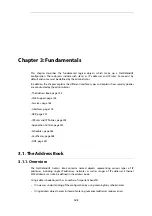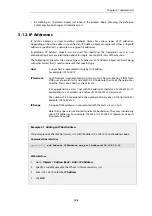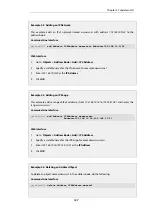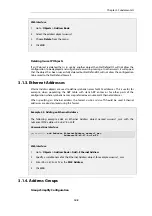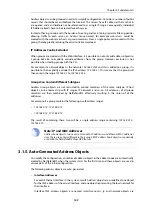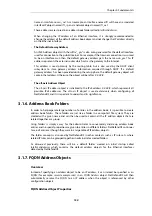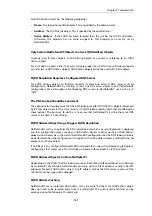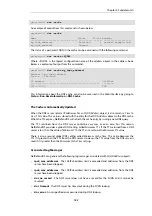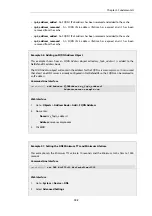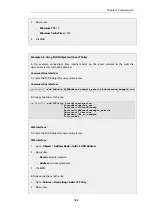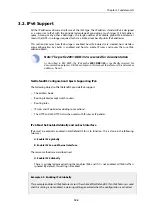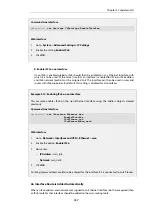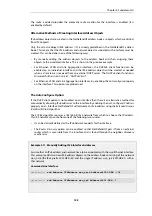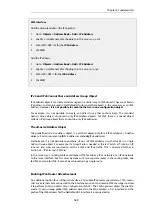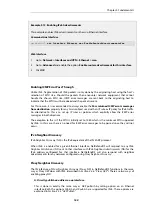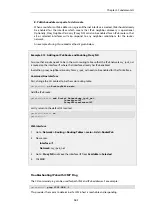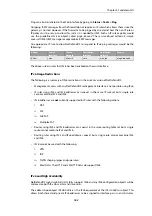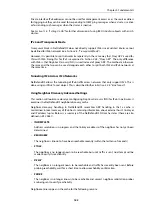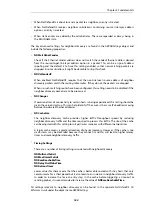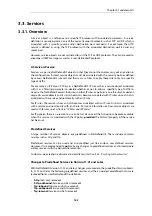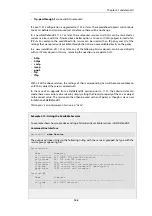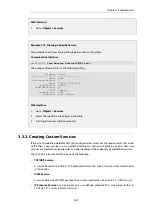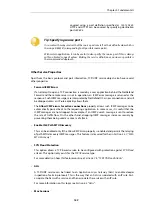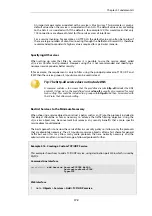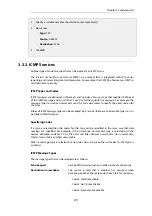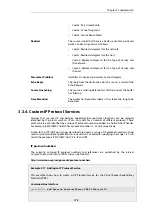
The route is added provided the automatic route creation for the interface is enabled (it is
enabled by default).
Alternative Methods of Creating Interface Address Objects
IPv6 address objects are created in the NetDefendOS address book as objects which are distinct
from IPv4 objects.
Only the
all-nets6
object (IPv6 address
::/0
) is already predefined in the NetDefendOS address
book. This means that the IPv6 address and network objects associated with interfaces must be
created. This can be done in one of the following ways:
•
By manually adding the address objects to the address book and then assigning these
objects to the associated interface. This is shown in the previous example.
•
For Ethernet, VLAN and Link Aggregation interfaces, the DHCPv6 client function can be
enabled on an individual interface and the IPv6 address objects will be created as needed
when a client lease is received from an external DHCP server. The DHCPv6 client function is
discussed further in
Section 5.6.1, “DHCPv6 Client”
.
•
For Ethernet, VLAN and Link Aggregation interfaces, by enabling the
Autoconfigure
property
on the interface. This option is explained next.
The Auto Configure Option
If the DHCP client option is not enabled on an interface then there is an alternative method for
automatically allocating IPv6 addresses to the interface. By enabling the
Auto Configure IP Address
property on an interface, NetDefendOS will calculate an IPv6 address using the
Extended Unique
Identifier
(EUI-64) algorithm.
The EUI-64 algorithm requires a /64 (64 bit) IPv6 network from which to choose the IP address.
This /64 network can come from one of the following two sources:
•
It can be statically defined as the IPv6
Network
property for the interface.
•
The
Router Discovery
option can be enabled so that NetDefendOS gets it from an external
router which is accessible from the interface and is found through the neighbor discovery
mechanism.
Example 3.11. Manually Adding IPv6 Interface Addresses
Assume that an IPv6 address and network have to be associated with the
wan
Ethernet interface.
This example adds two new IPv6 address objects to the address book consisting of the network
wan_net6
(the IPv6 prefix
2001:DB8::/32
) and the single IP address
wan_ip6
(
2001:DB8::1
) within
that network.
Command-Line Interface
gw-world:/> add Address IP6Address wan_net6 Address=2001:DB8::/32
gw-world:/> add Address IP6Address wan_ip6 Address=2001:DB8::1
Chapter 3: Fundamentals
158
Summary of Contents for NetDefendOS
Page 30: ...Figure 1 3 Packet Flow Schematic Part III Chapter 1 NetDefendOS Overview 30 ...
Page 32: ...Chapter 1 NetDefendOS Overview 32 ...
Page 144: ...Chapter 2 Management and Maintenance 144 ...
Page 284: ...Chapter 3 Fundamentals 284 ...
Page 392: ...Chapter 4 Routing 392 ...
Page 419: ... Host 2001 DB8 1 MAC 00 90 12 13 14 15 5 Click OK Chapter 5 DHCP Services 419 ...
Page 420: ...Chapter 5 DHCP Services 420 ...
Page 573: ...Chapter 6 Security Mechanisms 573 ...
Page 607: ...Chapter 7 Address Translation 607 ...
Page 666: ...Chapter 8 User Authentication 666 ...
Page 775: ...Chapter 9 VPN 775 ...
Page 819: ...Chapter 10 Traffic Management 819 ...
Page 842: ...Chapter 11 High Availability 842 ...
Page 866: ...Default Enabled Chapter 13 Advanced Settings 866 ...
Page 879: ...Chapter 13 Advanced Settings 879 ...


